Reports of Mullah Omar’s death bring alive the nerve-racking memories of the hijacking of Indian Airlines flight IC 814. The Taliban leader was not in touch with India, but his deeds gifted the country a frustrating Christmas in 1999.
In his recently released book, Kashmir: The Vajpayee Years, former R&AW chief A.S. Dulat has written about Omar’s clout when IC 814 was hijacked to Kandahar in Afghanistan. India was tracking the aircraft and contemplating a commando raid to rescue the hostages.
A team of negotiators, including current National Security Adviser Ajit Doval, was sent to Kandahar. They soon realised that the airport was a den of ISI agents.
The one-eyed mullah’s fighters, who surrounded the hijacked aircraft, were taking orders from ISI bosses inside the airport terminal. Dulat says it was a show of Omar’s strength, aimed at preventing any rescue operation.
Omar, who was the powerful Amir-ul-Momineen (Leader of the Faithful), was a puppet in the hands of the ISI. Jaswant Singh, who was the external affairs minister during the crisis, had sought a meeting with Omar to discuss the situation.
Omar’s secretary Wakil Ahmed Muttawakil initially replied: “Yes, why not?” But soon, he called back: “Sorry, you cannot. Don’t fly to Kandahar.”
“Muttavakil’s [sic] minders in the ISI must have upbraided him for even this little relenting,” writes Singh in his book, A Call to Honour.
Over the past few years, Omar was reduced to a mere fugitive in secret hideouts of Pakistan. Many Taliban leaders deserted the movement, but Omar was an exception. He remained elusive, and died in hiding.
Though the Taliban initially did not confirm his death, it announced on July 30 that Omar was dead, and his deputy, Mullah Akhtar Mansoor, would be the new chief of the insurgents.
Kabul Pressistan’s senior reporter Jamal Ahmad says, by disclosing Omar’s death, the Afghan government has blown a top secret guarded by the ISI.
 In 2001, THE WEEK had featured a sensational cover story on Omar, written by acclaimed Pakistani journalist Hamid Mir.
In 2001, THE WEEK had featured a sensational cover story on Omar, written by acclaimed Pakistani journalist Hamid Mir.
“Mullah Omar has not been seen in public for years, even in propaganda videos,” says Ahmad. “Yet, last week a statement was released which carried his support for the current talks between the Taliban and the Pakistan government. We expect an argument between Afghanistan and Pakistan on these ghost press notes that have been released since 2013 in the name of Mullah Omar.”
Omar was born in 1960 in Khakrez district of Kandahar province. His father, a locally respected Islamic preacher, died when Omar was a child. The young boy grew up steeped in the teachings of Afghanistan’s strict madrasas.
His scholarly life was disrupted when political unrest broke out in Afghanistan in the late 1970s. He became one of the first-wave of fighters against Soviet occupation of Afghanistan in 1979.
A biography published earlier this year says that his fighting skills, which endeared him to the ISI, were honed against the Soviets between 1983 and 1991. It was during this period that Omar was wounded four times and lost his right eye in a shrapnel shower.
The ISI trained nearly 300 ‘boys’, including Omar, in Peshawar and Kandahar. Soon, the massive jihad against the Soviet occupation launched by General Zia-ul-Haq of Pakistan spawned a vast number of mujahideen commanders who vied to be the ‘chosen one’ of their handlers.
In the end, only a handful prevailed. Pakistan picked Omar along with Gulbuddin Hekmatyar of the Hezb-e-Islami group as a fight broke out between the government of Dr Mohammed Najibullah and the mujahideen.
In the early 1990s, the deadly civil war decimated most parts of Kabul, and a new generation of Taliban commanders emerged. Omar was the silent type, while Hekmatyar grabbed the headlines for his fights against Najibullah.
Though he was rivalled by towering jihadi demigods such as Osama bin Laden and Hekmatyar, Omar will be most remembered for enforcing the brutal Taliban legal system, based on the strictest interpretation of the Sharia.
The jurisprudence under Omar led to routine executions and turned football stadiums and open fields into execution grounds. The killings and atrocities on men and women who failed to adhere to the Sharia turned Afghanistan into one of the worst performers on the global human rights index during the mid-1990s.
With Omar’s death, a major question has risen about the future of the peace talks between the Taliban and the Afghan government. Soon after Kabul confirmed the news of Omar’s death, the Taliban disowned reports about any such talks.
Now, that signals trouble for the fragile Afghan government. And, the coming months could see a spike in the Taliban versus Kabul violence.
Reports say Omar died “under mysterious circumstances” in a Karachi hospital. He was said to be hiding in the mountains bordering Pakistan and Afghanistan. The rugged region was his home ever since his famous escape on a motorcycle from Kandahar—where he was surrounded by US marines and anti-Taliban Afghan forces—to the Tora Bora mountains in October 2001.
Omar’s shadowy post-9/11 life will forever remain a subject of mystery and speculation. So will be his death.







